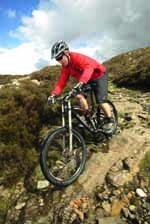 FRAME
FRAME
Specialized uses its AZ1 carbon-fibre fabrication technique to make the Enduro SL’s main triangle. Each carbon tube is moulded separately to ensure an even wall thickness, precise fibre orientation and to avoid wrinkles in the lay-up. The tubes are then mitred (in the same way as aluminium tubes) before being glued together. A paste, made of chopped fibres and epoxy, is then smoothed over the joints with additional layers of carbon wrapped around the whole thing.
The M5 aluminium rear triangle is then bolted to the main frame via a seat tube-mounted rocker link, which features cartridge bearings in all the pivots. To trim yet more weight Specialized has been pretty canny with the design of the rear end. For example, the rocker allows Specialized to use a full seat tube instead of an interrupted one, and this can be made lighter. Also, mounting the E-type front derailleur to the chainstay yoke negates the need for a round tube and the reinforcement that goes with it, which is often a heavy aluminium insert. At 28lb the Enduro is the lightest 6in bike on the market.
SUSPENSION
Another reason the S-Works is light compared to the competition is the new Specialized Future Shock e150 SL dual-crown fork; it weighs a claimed 4.5lb. There’s a lot of innovation packed into the e150 — it gets an integrated stem (available in 60 and 80mm lengths), titanium hardware, an aluminium steerer and 25mm thru-axle. There’s also an Attitude Adjust travel adjustment — turning the black dial of the left leg drops the ride height of the fork by 35mm — external rebound and compression adjustment, as well the facility to adjust the fork’s Spike Valve. This reduces high-speed compression spiking by increasing oil flow at higher shaft speeds. The same technology is available in the new AFR (active functional response) rear shock.
WHEELS
Specialized is the only company fitting lightweight rims but heavier tyres, in this case DT Swiss XR 4.2D 400g rims and dual-compound Resolution Pro 2.3in 700g tyres. The rear hub features a 9mm DT QR ratchet axle, which has some of the stiffness of a thru-axle but the convenience of a quick-release.
COMPONENTS
A kink halfway down the Thomson Elite aluminium seatpost means you can’t get the seat any lower than this bend, but it would be easy to switch to an in-line post, and it would be something we’d consider because the SL is pretty long and doesn’t really need the extra layback.
PERFORMANCE
The long wheelbase means it stays planted on steep technical climbs with very little wheel lift, but reducing fork travel lowers the bottom bracket by 10mm and steepens the head angle a degree, making ascents even easier. And while the 66.6deg head angle may seem like it belongs on a DH bike, there’s no more wheel flop when climbing than on the other bikes. In fact, because it’s so light, the Enduro is the best-climbing bike here.
A lot of people ask about mud and tyre clearance underneath the fork brace on the e150, especially since it moves directly underneath the crown, rather than to the side of it like a Fox fork. So far this hasn’t been an issue, although we’ve yet to test it in sticky clay.
To accommodate the adjustable travel Specialized has raised the bottom bracket slightly, which some say makes the Enduro feel surprisingly un-Specialized, but there’s no mistaking the compliant and fully active FSR rear end. It dealt with every kind of impact and was totally quiet on rough terrain. However, it did highlight shortcomings in the fork, which felt harsh.
VERDICT
It would be relatively easy to fit a Lyric or Fox 36 fork to the Enduro, but we wouldn’t recommend it. The e150 is 45-50mm shorter, so fitting either would just jack the angles and bottom bracket.
Specialized is working on improving the fork, but right now it’s the sticking point in this test and a reason this bike gets an eight.
MBR RATING: 8/10



